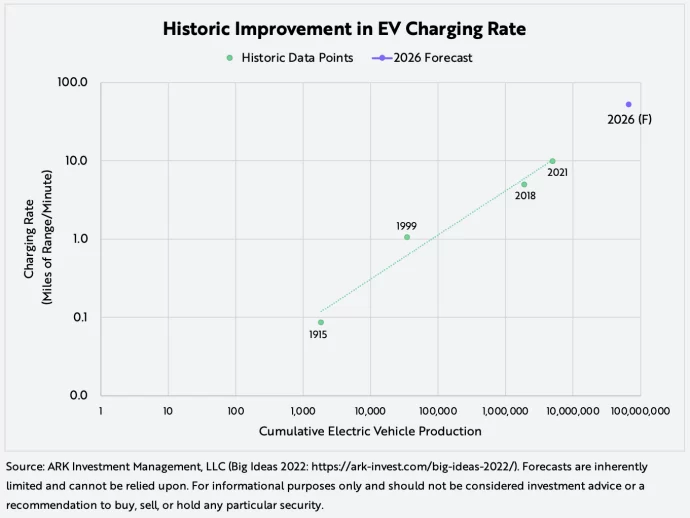#344: Tesla’s New 500-Mile-Range Semi Trucks Defy Skeptics, & More
1. Tesla’s New 500-Mile-Range Semi Trucks Defy Skeptics

Last week, Tesla delivered to PepsiCo the first in a 100-vehicle fleet of heavy-duty electric semi trucks with a driving range up to 500 miles.
Tesla demonstrated that, fully loaded, its semi truck made a 500-mile trip without recharging, thanks in part to its impressive regenerative braking capability. The semi truck traveled up and down the 4136 ft. Grapevine Mountain, which barely changed the slope of the battery usage curve, as shown below.

Source: Lambert, F. 2022 (https://electrek.co/2022/12/01/tesla-semi-delivering-disruptive-electric-truck/). For informational purposes only and should not be considered investment advice or a recommendation to buy, sell, or hold any particular security.
During the event, Tesla also disclosed the Cybertruck’s charging power. According to ARK’s research, Wright’s Law can forecast improvements in electric vehicle charging rates, as shown below. A useful metric that incorporates the efficiency, range, and power capabilities of battery systems is miles of range added per minute charged. Importantly, both the semi truck and the Cybertruck use 1 MW chargers. If it does deliver the Cybertruck with charging power as disclosed at this event, then Tesla could reach the EV performance that ARK had projected for 2026 in 2023, three years ahead of schedule!

2. Amazon’s New “Omics” Cloud Service Will Support The Next Wave Of Data-Driven Healthcare
Over the past decade, Amazon’s (AMZN) Amazon Web Services (AWS) helped life sciences research groups migrate data storage and compute workloads from less efficient in-house solutions. With life sciences data analytics capacity and cloud-based storage, Amazon’s Genomics Command Line Interface (CLI) has provided researchers with a purpose-built solution to analyze genetic data.
Earlier this week, Amazon launched a new service called Amazon Omics, demonstrating its commitment to the next wave of exponential growth in healthcare data. Amazon Omics offers three services––data storage, bioinformatics workflows, and analytics––that customers can use individually or collectively. Even non-experts will be able to transform raw sequence data into more structured query-able formats, not only storing them in the cloud but also scaling and analyzing industry-standard or custom bioinformatics workflows with petabytes of multiomics datasets. Amazon Omics seems to be a substantial improvement over Amazon’s existing cloud suite and is likely to attract more users with added workflows.
In the near-term, smaller groups prioritizing scientific research over building backend infrastructure should benefit most from Amazon Omics. The platform features secure logging and auditing that researchers working with sensitive health data should find quite useful. Over the medium and longer terms, some of the largest population health efforts in life sciences are likely to gravitate toward Amazon Omics, galvanized by the next leg of cost declines for both short- and long-read sequencing systems. This time, however, Amazon will have more competition, as NVIDIA (NVDA) recently expanded its own life sciences cloud service, Clara.
3. OpenAI Launches ChatGPT
Last week, OpenAI released a conversational AI model called ChatGPT. We asked ChatGPT to create a blog post about itself. In a few seconds, it generated this paragraph:
ChatGPT uses a cutting-edge approach called transfer learning to build upon the knowledge and capabilities of previous language models. This allows it to quickly adapt to new tasks and environments, making it an ideal choice for a wide range of applications. One of the key features of ChatGPT is its ability to understand and respond to natural language input. This means that developers can use it to create AI assistants that can hold a conversation with users in a way that feels more natural and engaging. Another key advantage of ChatGPT is its ability to generate text that is both coherent and diverse. This makes it an ideal choice for applications that require the generation of long-form text, such as chatbots, virtual assistants, and other conversational AI applications. Overall, ChatGPT is a powerful new tool that has the potential to revolutionize the way we interact with conversational AI. Its ability to understand and respond to natural language input, as well as its ability to generate coherent and diverse text, make it a valuable asset for developers looking to create more engaging and realistic conversational AI applications.
In addition to prose, the ChatGPT can write poems, movie scripts, and academic essays. It can explain quantum physics, tutor math, and even write software code. If a user asks it to write a program to process payments on Stripe, for example, ChatGPT will generate a code snippet that communicates with the Stripe Payment API. That said, at this early stage, ChatGPT is prone to “hallucinations” that will require students, programmers, and other authors to check “their work” before considering it complete.
Readers can try the open-access model at: https://chat.openai.com/chat.
In our view, AI will transform education and knowledge-work. With ChatGPT, students now can generate essays or code in seconds, and script writers’ movies or plays in minutes. With more iterations and breakthroughs, the possibilities seem open-ended.
According to ARK’s recent research, AI should more than double the productivity of knowledge workers by 2030, potentially boosting real GDP by $56 trillion, but based on recent breakthroughs, that estimate could be too conservative. GitHub Co-Pilot already can double the productivity of software engineers performing coding tasks, and now ChatGPT will turbocharge the progress.


